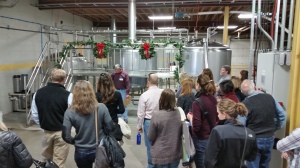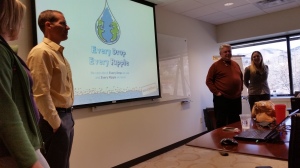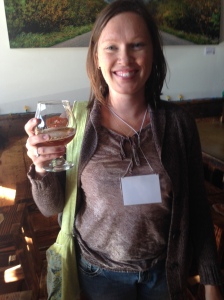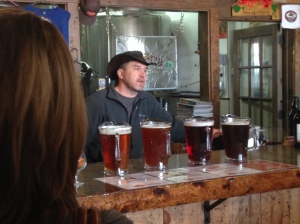Early this week, the Your Water Colorado Blog looked at water for agriculture, the state’s largest water user. Now, we’ll continue exploring the ways in which people value and depend on water in Colorado by taking a look at water for industry… specifically an industry dear to the hearts of many Coloradans—brewing. Julie Kallenberger with the Colorado Water Institute attended the Colorado’s Foundation for Water Education’s Water for Brewing Tour in December and guest blogs on the water efficiency and leadership efforts that local breweries are taking on small and large scales. Read her post below, and check out the Water and Beer radio program from Connecting the Drops, posted a few months ago.
By Julie Kallenberger
Clean water is arguably the key ingredient in beer, making up 95% of the total volume, this limited resource is important to the brewing industry—and the industry is important to Colorado. Across the U.S., there are over 2,800 craft and non-craft breweries that contribute more than $100 billion to the overall beer market. In Colorado alone, over 1.4 million barrels of beer were produced by 175 craft breweries in 2013. This results in a $1.6 million economic impact across the state.

Tour participants see where beer is brewed and gain an understanding of water use in the brewing process at Diebolt.
Recognizing the demand for education on this topic, the Colorado Foundation for Water Education hosted a one-day Water for Brewing tour last month. On the tour, a diverse mix of water professionals, brewery industry representatives, educators, and interested citizens learned about water use and efficiency at three breweries in the Denver area: Strange Craft Beer Company, Diebolt Brewing, and MillerCoors. Participants also gained knowledge about the brewing process and efforts by those in the industry paving the way for continued conversation, efficiency, and sustainability.
Water Efficiency
Water usage can vary from brewer to brewer, with an average water-to-beer ratio of seven barrels to one barrel of beer (1 beer barrel = 31 gallons). However, some breweries use far less water at a rate of 4:1, and some are highly efficient at 3:1 and strive to become even more efficient. The ratio can fluctuate based on many factors, including consumer preferences for more water intensive styles (i.e. hoppy beers).
Motivation for improved efficiency throughout the brewing process is evident. Several opportunities exist for increasing product yield while decreasing water use.
MillerCoors has implemented water conservation and efficiency measures such as decreasing rinse cycle times, rebuilding sand filters, investing in high efficiency brew kettles, recirculating water instead of using freshwater for cooling, recapturing and reusing wastewater for uses not directly related to beer products, installing waterless lubrications throughout their operation, and implementing anaerobic digestion plans to treat wastewater effluent. These practices, combined with cultural and behavioral changes, have allowed them to surpass their reduction targets two years in advance. Moreover, they have set a goal of reducing their water intensity by 2020 from a 2011 baseline by 15 percent.
Strange Craft reduced their water use by 30 percent, saving 15-20,000 gallons/month by reusing water used for chilling wort in cleaning equipment, the heat exchanger, and their boil kettle. Diebolt Brewing uses a closed loop glycol steam system to chill their wort and reuses their hot water for cleaning along with a power washer to reduce water use. But, the craft breweries we visited expressed a concern over the lack of meters to tell them exactly how much water they use during each step of the process. Like other breweries, Strange Craft and Diebolt have experienced big growth and changes in their process over a relatively short time. Originally, Strange Craft shared a water meter with next-door businesses, though now they have an individual meter so they can account and manage their water use. Diebolt has one meter that tracks their entire use (approximately 7,000 gallons/month or 1,500 gallons per batch), including the water in the tasting room and restrooms. They anticipate installing additional meters in the future.
Leadership
Opportunities for partnership and sharing ideas among breweries and other stakeholders are plenty. Tim Myers with Strange Craft Beer Company explained how they are taking a leadership role by sharing lessons learned about water savings and efficiency with new breweries in the Denver area and hosting events such as Beer Not Water.

Ben Moline with Molson Coors explains their corporate responsibility policy and Colorado water portfolio.
Molson Coors’ Every Drop Every Ripple initiative illustrates their commitment to watershed health, use and management, water education, and working together with their suppliers to reduce waste along the entire supply chain. They have formed partnerships with organizations such as Circle of Blue, the Beverage Industry Environmental Roundtable (BIER), The Greenway Foundation, and with stakeholders throughout the communities where they operate to address water concerns and reduce their impact on the environment.
Another example of leadership and collaboration is BreWater, a group of breweries in the greater Fort Collins area who collaborate to learn and share best practices and invest resources in local water projects. The goals of BreWater include educating themselves, as well as other stakeholders about water issues, connecting with community members, and playing an active role in water quality protection and availability.
Some in the brewing industry have provided input into the draft of State Water Plan that was delivered to the governor at the beginning of December. Ben Moline with Molson Coors states their biggest concerns are reliable storage infrastructure and ensuring their water rights are secure over the long term. With growth and drought on the horizon, among other pressures, they understand the importance of playing an active role in the development of the plan to safeguard clean, reliable water supplies.
The future looks bright for the brewing industry in Colorado even in the face of water quality and quantity uncertainties. While this post focused on the efforts of the breweries we visited on the tour, many others are also working hard to become as water efficient and environmentally sustainable as possible.
Cheers to a fun, educational tour!
Julie
 Julie serves as the Education and Outreach Specialist for the Colorado Water Institute where she adopts various roles to help address, educate, and facilitate conversation about high priority water issues throughout Colorado and surrounding states. Julie’s current research focuses on projects related to Colorado’s energy-water nexus and agricultural water use and efficiency in the Colorado River Basin. She also serves as the Research and Outreach Coordinator for the CSU Water Center where she facilitate water research and learning with faculty, staff, and students across campus. In Julie’s free time, she enjoys spending quality time with friends, family and her dog Leo, playing outdoors, and experiencing new styles and flavors of beer – she says, the best of days are when all of these occur at the same time. Julie is also a member of the Fort Collins Beer Bettys, a beer club hosted by The Mayor of Old Town in Fort Collins designed for women to learn from select brewery representatives about brewing processes, products, practices, and to meet others interested in all things beer.
Julie serves as the Education and Outreach Specialist for the Colorado Water Institute where she adopts various roles to help address, educate, and facilitate conversation about high priority water issues throughout Colorado and surrounding states. Julie’s current research focuses on projects related to Colorado’s energy-water nexus and agricultural water use and efficiency in the Colorado River Basin. She also serves as the Research and Outreach Coordinator for the CSU Water Center where she facilitate water research and learning with faculty, staff, and students across campus. In Julie’s free time, she enjoys spending quality time with friends, family and her dog Leo, playing outdoors, and experiencing new styles and flavors of beer – she says, the best of days are when all of these occur at the same time. Julie is also a member of the Fort Collins Beer Bettys, a beer club hosted by The Mayor of Old Town in Fort Collins designed for women to learn from select brewery representatives about brewing processes, products, practices, and to meet others interested in all things beer.


 Print
Print
Reblogged this on Coyote Gulch.